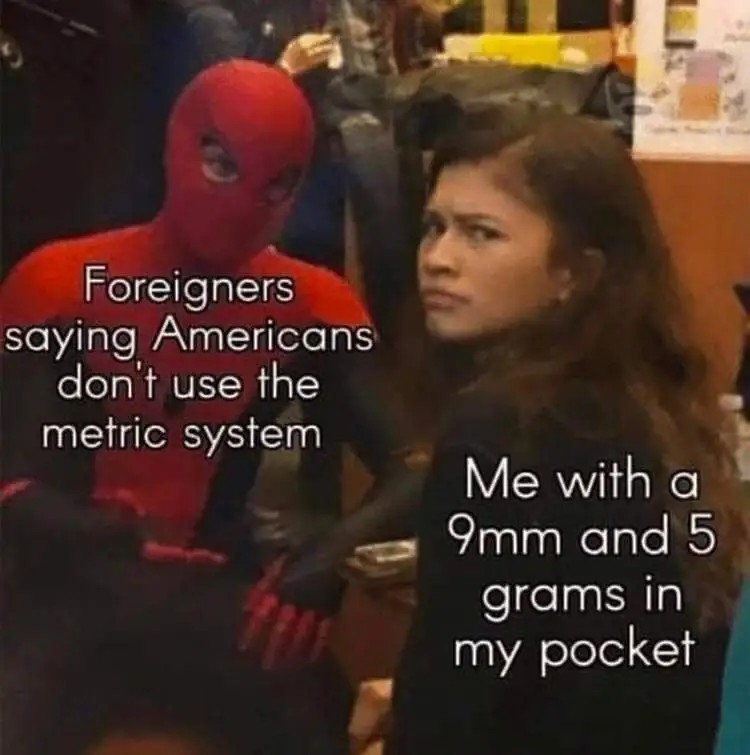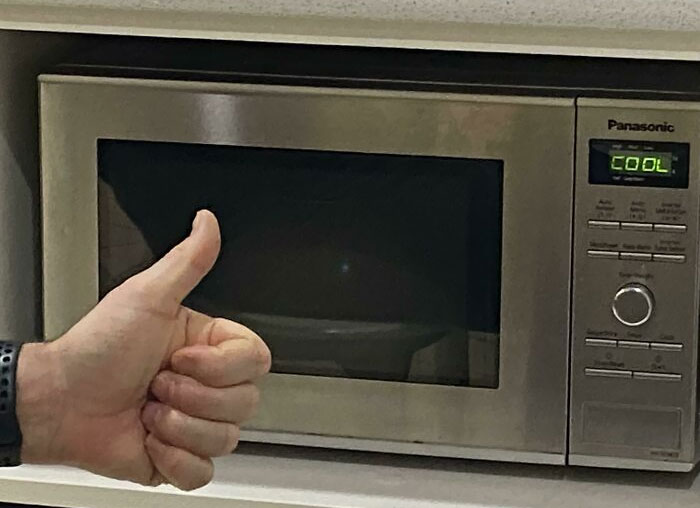The imperial system makes you a worse shot. Everybody in American stories misses by inches. In European stories, they miss by millimeters. It’s quite the difference: 25 times worse.
It’s not a real fish tale if people are measuring in standard units instead of “c-hairs” or “gnat bollocks” anyway.
Longtime woodworker here (American). Fractions of an inch have always been a pain. Finished lumber like 2x4s and 1x12s have never in my lifetime been the size they’re known as, but that’s a matter of subtracting halves and quarters of an inch and everybody was used to it. Then maybe 20 years ago (no need to correct me, it really doesn’t matter) companies decided that instead of making plywood the thickness they said it was, they would subtract 1/32th of an inch, because hey less wood means more profits! So for example a sheet of so-called 3/4" plywood is only 23/32" thick. Similarly with half-inch, etc. This means a slot cut with a 3/4" router bit, which used to fit a 3/4" thick shelf, is just slightly loose now, and if you are stacking multiple thicknesses the slight inaccuracies compound themselves. What the Actual Fuck. I have a metric tape measure, which makes some figuring easier, but inches and fractions of inches don’t convert to exact mm. The imperial system is a shit show.
I recently bought a house that was built in 1942 and I’ve been renovating it. I tore down one of the interior walls and reused the studs (which incidentally were completely straight and free of knots, unlike any modern 2x4 I’ve ever seen) to build a new wall. When I put the wall in place it didn’t quite fit and when I measured I realized it was 1/2" too tall. I don’t normally make measurement errors of that magnitude and it took me a while to figure out that the studs I was reusing were not 3.5"x1.5" like modern 2x4s but were actually 3.75"x1.75" (so the base plate and head plate being thicker than I thought was producing the problem). Apparently the transition from real 2x4 to BS 2x4 dimensions was gradual, who knew.
One other weird thing was how the interior walls and ceilings were covered. I’ve worked on a lot of 19th century houses with lathe and plaster and of course I’ve worked with modern sheet rock. This 1942 house was in a transitional phase that used 16"x16" blocks of 1" thick rough plaster that were nailed to the studs, and then finish plasterers came in and put a smooth plaster coat over these rough blocks. I’ve never seen anything like that before, and removing these rough plaster blocks was a monstrous bitch - each one weighs as much as a solid rock of those dimensions and I have no idea how a few nails were holding them up on the ceiling joists.
Also found a hat in the attic from 1942. I like to imagine some young worker wondering for the rest of his life where he put his favorite hat.
That’s fascinating, I never heard of those small plaster panels - could they be a type of Sackett Board? According to Wikipedia they were made in 36" panels, maybe there were also smaller ones - although 1942 would be kind of late for them.
Finding that hat is awesome! Was it a “slouch hat” workers commonly wore? The coolest thing I’ve found in my 1910 house was a WWII draft card inside a wall - I think it fell through a very thin gap between the windowsill boards. Always wondered if the guy put it there intentionally or what.
I don’t think they’re Sackett Board as they’re much thicker and heavier than 1/4" and they’re not layered in any way. They are preformed plaster and they have sort of tongue-and-groove edges like modern ceiling tiles so that two edges are supported by neighboring panels so as they’re installed they only have to be nailed off on two edges. Installation must have been a two-man job, at least on the ceiling. The houses in my neighborhood were built as temporary housing for shipyard workers and were certainly never meant to last 80+ years, and yet here they all still are - only two of the original 320 are gone and they were torn down intentionally to make room for a baseball diamond. I watch these house inspector videos on Youtube and just laugh my ass off at what pieces of utter shit modern houses are.
The hat wasn’t a slouch hat unless that term is broader than I think. It was green waxed canvas with a small front brim and little ear flaps with ties. It even had a tag with the contract number and year on it, which confirmed when the house was built. I was going to wear it but it had a bunch of little moth- or other-critter- holes in it and I stupidly threw it away.
use cabinet grade instead of construction grade for your plywood. The good shit will actually be what it says it is.
I didn’t know that. But at this point I can barely afford sanded shop plywood from Home Depot.
went to my local orange store today, measured the plywood while I was there. The birch is a full 3/4, but the sandeply is 23/32 despite being labeled as 3/4.
I am annoyed.
And the druggies. Somehow, they had no trouble switching to metric.
Hey, we use grams and kilos for…other things too.
Yeah but now I know that there are 28.5 grams in an ounce
28.35. And don’t expect more than 28. 3.5x8=28, and since every bag can’t be exact, that’s why lots of plugs have a bag or two that are just under.
deleted by creator
Sounds like they wanted engines that work.
So about anything but European.
Nothing wrong with German or French engines, but I admit British and Italian engines aren’t the greatest for not breaking down.
Volkswagen engines are pretty good at breaking down, imo. I will say there have been a fair amount of good bmw engines.
I’ve owned a few Volkswagens and yes when they are over 12:years old they start having issues, before that they never ever let me down.
Yep. Not sure when that became common, but my late 90s and early 2000s vehicles were like that. My late-model domestic car is all metric, though, so at least Ford standardized.
They all did. Everything in the auto industry is metric these days across all brands.
Tire sizes too? For some reason we get funny sizes for tires and bike frames in Europe. I don’t really know what they’re based on, they do seen to have some kind of connection to imperial/cistomary but I never really know how it’s measured.
Good point. Forgot about tires. Tire sizes here are a mix of metric and imperial. My tires are 245 40R19, so 245mm wide, 40% sidewall ratio, on a 19" rim.
It there some kind of tool lobby out there making Americans buy multiple tools to resolve functionally one identical task?!
Eh, the brits do that too, don’t they? Buncha weirdos I tell you.
Tbf, some other countries are schizophrenic about it, too. The UK uses miles for some distances and km for others, metres for anything more than about a body-length, when it might switch to feet depending on context or location. That doesn’t even broach other (sometimes overlapping) units. Humans are* remarkably inconsistent considering how universally we talk about things relying on measurement.
I think I also recall some comments from somewhere from UK people saying Fahrenheit makes more sense for weather-related temperature.
But yeah, definitely human inconsistency lol.
Every US company I’ve (engineer) worked for has been a metric company
I (machinist) have only seen a few large US firms or companies send me a metric print. Different worlds, I guess.
As an engineer who dabbles in machining, that checks out. What really grinds my gears (sometimes literally) is how sometimes people use fractions of an inch and sometimes people use decimals.
That is usually related to tolerances, though. Like 0.1250 is interpreted much differently than 1/8".
Took me a while to realize that Caliber is roughly inch/100. Once I did I no longer needed to memorize them.
I don’t understand. A 5.56mm round has a .223 bullet. .223 is the caliber and is in inches already, no math required. .223 / 100 =0.00223 which isn’t particularly useful.
caliber
dodge caliber
.233 bullet
bullet is ~1/4 the size of a compact vehicle
us military: ERECT
Their math was flawed, but I’m not really sure how to explain the math part better. I get what they were going for, though.
It’s closer to decimal divisions of an inch, so a .223 caliber bullet would be a hair shy of a quarter of an inch (.25) wide.
Edit: just realized you had the second part of that already
That still makes no sense. Is the commenter surprised to learn that a 0.223 inch caliber is approximately 0.223 inches? That a .45 inch caliber is about .45 inches? Yes, that’s how units work.
But you don’t call it “point four five caliber” you call it “forty five caliber”. Similar is 7.62 mm AKA “thirty caliber”. It’s reasonable that someone wouldn’t know that it’s literally just hundredths of inches.
Shotgun gauge is wonky, so it’s not a given that the number would just be a diameter in units they are familiar with. “Grains” are also available meaningless unit to most people.
What do you mean? its 7000 grains in a pound. 27ish grains to a dram, 16 drams to an ounce, and 16 ounces to a pound. Pretty straight forward.
Also dont confuse an ounce(oz) and a fluid ounce(fl oz). That’s 8 fluid drams to a fl oz, 16 fl oz to a pint, 2 pints to a quart, and 4 quarts to a fucking gallon cause it makes sense. Obviously, 63 gallons to the hogshead.
Shotgun gauge is wonky, so it’s not a given that the number would just be a diameter in units they are familiar with.
Yeah, it’s not intuitive that bigger gauge numbers = narrower diameter unless you’ve specifically worked with wire or shotguns before.
and drugs
cops: “9mm is too weak! we need something with 'stopping power!”
gun people: “ok here’s 10mm”
cops: “too much recoil!”
gun people: “ok here’s .40 s&w”
cops: “u no wat, we’re just gonna stick with 9mm”
They so stupid, they unconsciously use it everyday for example to calculate medicines’ dosages or measuring time (miliseconds), it only shows how backwards and limited their measurement system really is.
Lel imagine only using one system of measurement and thinking it’s somehow superior.

LOL the 196 nazi mods unsurprisingly banned me.
"what completely altruist country you’re posting from. " Did you want to try a whataboutism?
Whatever it is, it, or any other country on the planet, it doesn’t compare in the least to yours.
It’s quite a gap from ‘not being completely altruisic’ and tbeing the worst imperialistic warcrime commiting, looting and invading cancer of the world that is the US banana republic.
Bye now, enjoy your shithole circling the drainCool utterly cowardly response. I probably wouldn’t have even bothered if I had such a weak rebuttal.
How I envy all them stones. They don’t never say a word.
Time is mostly base 60. It goes against the metric system based 10.
It’s like saying milifoot. For 1/1000th of a foot. Doesn’t make it a metric unit.
What I meant by my comment is that 1ms = 1/1000s, and the prefix “milli” is metric, ik time isnt metri, I should’ve explained that differently in my previous comment cus it indeed imply that time is metric. Thank you for correction!
whats fucking weird to me is that we use millimeters and inches on the same fucking rulers.
M’erican here. My workshop is 100% metric. I do far too much measuring, designing and planning to fuck around with inches, feet and football fields. Motherfuck the imperial system. America has been robbed of the superior until of measurement. Every last bit of my work is in millimeters and it will be that way until I die in a horrible firey accident in my shop because beer and dangerous power tools are just too much fun when taken together.
The only thing I will hand to the imperial system is how it uses inches. Then again that’s really a part of the system but of its practical use.
What I like is the use of parts of inches. Especially the fractions which are powers of two. Very useful. That’s a little difficult with the cm and mm because they’re already so small. And a dm is quite large on the other hand.
I know my uncle uses inches to make flutes e.g. Supposedly helps with getting things lined up and accurate to tune. I dunno. But yeah. Otherwise, metric ftw.
What I like is the use of parts of inches. Especially the fractions which are powers of two. Very useful. That’s a little difficult with the cm and mm because they’re already so small.
What? With millimeters you barely have to use fractions because it is so small, how is that a negative? Fractions are also way harder to understand if you need to het precise
You’ve already gotten two real world uses here.
I’m not saying millimeters are a negative. Never did I say that. But I will say a base 10 doesn’t have that many prime factors, so using measurement equipment where halves and thirds and smaller marked out can be pretty helpful. Metric measuring stuff never has that.
I’m just saying that if you are working with some kind of base size, and want to do stuff in fractions or multiple of that base size, the inch is a pretty good size. 👍
I’m from and in Europe, and I don’t use inches myself. But there are obviously good uses for it.
I’m just saying that if you are working with some kind of base size, and want to do stuff in fractions or multiple of that base size, the inch is a pretty good size. 👍
I have a hard time understanding why you would prefer that over using decimal places to be honest, adding decimal places together is much simpler than different fractions
Not flute working but sewing, and I know it sounds insane, but mm is just to small to be practical. It’s one or two strands of tread whereas 1/4 or even 1/8 gives a proper piece to cut of.
And 1/4 inch seem allowance is just so much less bulky than the standard 0,75 cm, and so much more intuitive for me to work with … and f. I just realized that all my arguments for using inches are based on habits…
Even though I’m european I never really applied cm in anything but homework and therefore never got a real sense of it. And a lot of the nice sewing patterns are in inches so that’s where i started.
Well habits are valid and in the end a cm is just as arbitrary as an inch, but converting between units is just objectively easier with metric
Fractions are also way harder to understand if you need to [g]et precise
Not gonna lie, if you are working with carpentry or sewing or similar construction or creative work, you probably shouldn’t have any issues with fractions…
Just try adding 1/3 and 5/8. In my field fractions like that are nowhere near precise enough anyways, so you’d need to work with thousands of inches, which just makes you wish there was a smaller unit like millimeters
Just try adding 1/3 and 5/8.
Cherry-picking fractions with prime numbers. 👍 Obviously no harder than using a readily available calculator just like any engineer would with the metric system. That’s fine too. You’d end up with a decimal answer, so then the benefit is lost, just as with fractions of cm.
In my field
Yup, say no more. I’m not saying inches are universally better. Only in certain situations.
I don’t see how cherry picking is an issue when that issue literally can’t happen when you’re working with fractions, I also don’t think those sizes are particularly uncommon?
I don’t see how cherry picking is an issue
Cherry-picking is an issue when you’re trying to make an argument because you’re choosing a very complicated case on purpose when the more common cases are less complicated. That’s gotta be a straw man argument or something similar? I dunno.
literally can’t happen when you’re working with fractions
Did you mean to say something other than fractions here? If not, I’m confused.
don’t think those sizes are particularly uncommon?
It depends if you are making your own shit or not. You can always decide on other sizes, I guess? But no, they’re not uncommon. But combined, maybe not as common as other combinations? Either way, like I said, the easier cases still make the case for a slightly larger base like the inch. The other cases you can just use cm/mm or a calculator if it’s too much.
Just to be clear, this has nothing to do with the imperial system itself. It’s only the fact that the inch is a more comfortable size. You could easily just use a base of 2 cm or something and use fractions of that. But common measuring devices rarely mark even fractions of cm. That’s the only issue.
How dare you!
We also measure our drugs that way
And some science stuff. Often related to drugs.
And computing.
And our largest bottles of soda.
Literally all of your food and drinks in America are sold by the metric unit. That’s why it is on the packaging. Your “fifth” of vodka is actually 750ml and is not 1/5 of a gallon.
And alcohol!
And alcohol!
Really? And here I thought it was still in those really confusing Florida ounces. Even up here in Canada, where we do have millilitres marked on our cans, I still see “Fl oz” on many products.
When I buy a handle, I don’t know how many ounces are in it, just that there’s 1.75L in it.
And my axe!
And my Glock!
Glock is Austrian. They just love the US market.
I think most gun makers like the American market
And my crippling medical debt.
And alcohol!
Really? And here I thought it was still in those really confusing Florida ounces. Even up here in Canada, where we do have millilitres marked on our cans, I still see “Fl oz” on many products.
That’s done intentionally to obfuscate the quantity, since most Americans can more easily estimate a half-gallon. It’s to encourage consumption.
Doubt intensifies
Sorry, but the entire u.s. economy is actually run on this kind of scam logic. Honest people are run out or killed a few years in. Like with cops. It’s in the college textbooks, but naturally none of the news channels can cover the details at any length, due to conflict of interest in funding.
Like a goddamn liter cola
And distances in track and field events
And the temperature of electronic components for some reason
Lower numbers look better for that so it’s like a cheat code for them.
“wow, if I buy this gpu, my room will be literally freezing when I’m not playing a game, and it warms up to around 80 once I launch something? The fuck do I need an air conditioner for?”
Most of us know what two liters of carbonated sugar water looks like.
Hey, that’s flavored carbonated sugar water if you don’t mind.
Also wetsuits…? 🤷♀️
Oh no, it’s worse than that… we use the metric system to measure the customary system…
The Mendenhall Order marked a decision to change the fundamental standards of length and mass of the United States from the customary standards based on those of England to metric standards. It was issued on April 5, 1893, by Thomas Corwin Mendenhall.
[…]
Mendenhall ordered that the standards used for the most accurate length and mass comparison change from certain yard and pound objects to certain meter and kilogram objects, but did not require anyone outside of the Office of Weights and Measures to change from the customary units to the metric system.https://en.wikipedia.org/wiki/Mendenhall_Order
Technically every unit in the US customary measurement system is just a weird conversion factor of an equivalent metric unit. At this point 1 yard was defined as 3600/3937 meter, which means 1 inch = 2.54000508 cm. By 1959 everyone finally agreed that this was stupid and redefined it as 1 yard = 0.9144 m (1 inch = 2.54 cm).
All measurements in the US are based on standard reference objects provided by BIPM.















